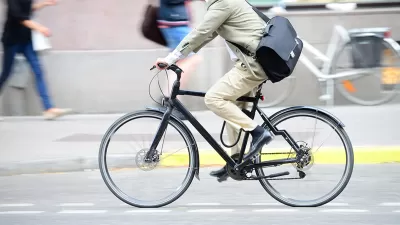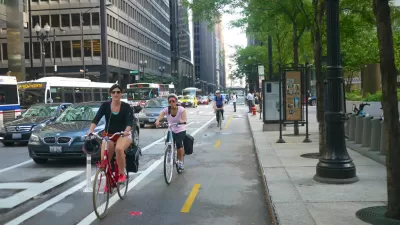Many U.S. cities are seeing an increase in bicycle commuters, according to a U.S. Census Bureau report released last week. Of all commute modes, biking increased the most from 2000 to 2012. Walking, however, held steady.

"Nationwide, the number of people who traveled to work by bike increased roughly 60 percent over the last decade, from about 488,000 in 2000 to about 786,000 during the 2008-2012 period. This is the largest percentage increase of all commuting modes tracked by the 2000 Census and the 2008-2012 American Community Survey," according to a press release announcing the United States Census Bureau's new report, titled "Modes Less Traveled—Bicycling and Walking to Work in the United States: 2008–2012."
Moreover, "[while] bicyclists still account for just 0.6 percent of all commuters, some of the nation's largest cities have more than doubled their rates since 2000. Portland, Ore., had the highest bicycle-commuting rate at 6.1 percent, up from 1.8 percent in 2000. In Minneapolis, the rate increased from 1.9 percent to 4.1 percent."
The results for walking, however, held steady: "After steadily decreasing since 1980, the percent of people who walk to work has stabilized since 2000. In 1980, 5.6 percent of workers walked to work, and that rate declined to 2.9 percent by 2000. However, in the 2008-2012 period, the rate of walkers remained statistically unchanged from 2000."
On the same day as the study, the Census also released a new commuting edition of the interactive map Census Explorer. Planetizen blogger Michael Lewyn already crunched that data about average commute times in cities and suburbs around the country.
Michael Stenzel has also analyzed some of the data in the report, especially with regard to the growing rate of walking and biking to work in Chicago: "In Chicago in 2000, 5.7% of workers walked to work, but by 2012, the percent had increased to 6.4%," and "in 2000, only half a percent of Chicagoans rode their bikes to work, but by 2012, it was 1.3%."
FULL STORY: Biking to Work Increases 60 Percent Over Last Decade, Census Bureau Reports

Planetizen Federal Action Tracker
A weekly monitor of how Trump’s orders and actions are impacting planners and planning in America.

Congressman Proposes Bill to Rename DC Metro “Trump Train”
The Make Autorail Great Again Act would withhold federal funding to the system until the Washington Metropolitan Area Transit Authority (WMATA), rebrands as the Washington Metropolitan Authority for Greater Access (WMAGA).

The Simple Legislative Tool Transforming Vacant Downtowns
In California, Michigan and Georgia, an easy win is bringing dollars — and delight — back to city centers.

The States Losing Rural Delivery Rooms at an Alarming Pace
In some states, as few as 9% of rural hospitals still deliver babies. As a result, rising pre-term births, no adequate pre-term care and "harrowing" close calls are a growing reality.

The Small South Asian Republic Going all in on EVs
Thanks to one simple policy change less than five years ago, 65% of new cars in this Himalayan country are now electric.

DC Backpedals on Bike Lane Protection, Swaps Barriers for Paint
Citing aesthetic concerns, the city is removing the concrete barriers and flexposts that once separated Arizona Avenue cyclists from motor vehicles.
Urban Design for Planners 1: Software Tools
This six-course series explores essential urban design concepts using open source software and equips planners with the tools they need to participate fully in the urban design process.
Planning for Universal Design
Learn the tools for implementing Universal Design in planning regulations.
Smith Gee Studio
City of Charlotte
City of Camden Redevelopment Agency
City of Astoria
Transportation Research & Education Center (TREC) at Portland State University
US High Speed Rail Association
City of Camden Redevelopment Agency
Municipality of Princeton (NJ)





























